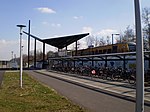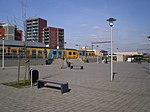Ter Horst Castle
Castles in Gelderland

Ter Horst Castle is a castle northeast of the village of Loenen, in the Dutch province of Gelderland, on the road to Klarenbeek. In 1557, the then mayor of Arnhem Wynant Hacfort had the castle built.
Excerpt from the Wikipedia article Ter Horst Castle (License: CC BY-SA 3.0, Authors, Images).Ter Horst Castle
Mei-Allee, Apeldoorn
Geographical coordinates (GPS) Address Nearby Places Show on map
Geographical coordinates (GPS)
| Latitude | Longitude |
|---|---|
| N 52.124444444444 ° | E 6.0291666666667 ° |
Address
Landgoed Ter Horst
Mei-Allee
7371 EH Apeldoorn
Gelderland, Netherlands
Open on Google Maps











